High Impact Tutoring Built By Math Experts
Personalized standards-aligned one-on-one math tutoring for schools and districts
In order to access this I need to be confident with:
Symmetry Lines of symmetry 2D shapes Coordinate plane Linear graphHorizontal and vertical line graphs
Reflection in math
Here you will learn how to reflect 2D shapes on the coordinate plane and how to describe a reflection in math.
Students will first learn about reflections in math as part of geometry in 8 th grade.
What is reflection?
A reflection in math is a type of transformation that flips a shape across a line of reflection (also called a mirror line) so that each point is the same distance from the line of reflection as its reflected point.
The original shape or original image is called the pre-image and the reflected shape is called the image, reflected image, or mirror image.
For example,
Triangle P has been reflected across the line x=4 to give Triangle Q.

Triangle P is the original shape and Triangle Q is the image.
When a shape is reflected, the original shape and the image are mirror images of each other.
You can see that each point of triangle P is the same distance from the line of reflection as the corresponding point on triangle Q.
The two triangles are congruent because they are the same shape and the same size.
What is reflection?
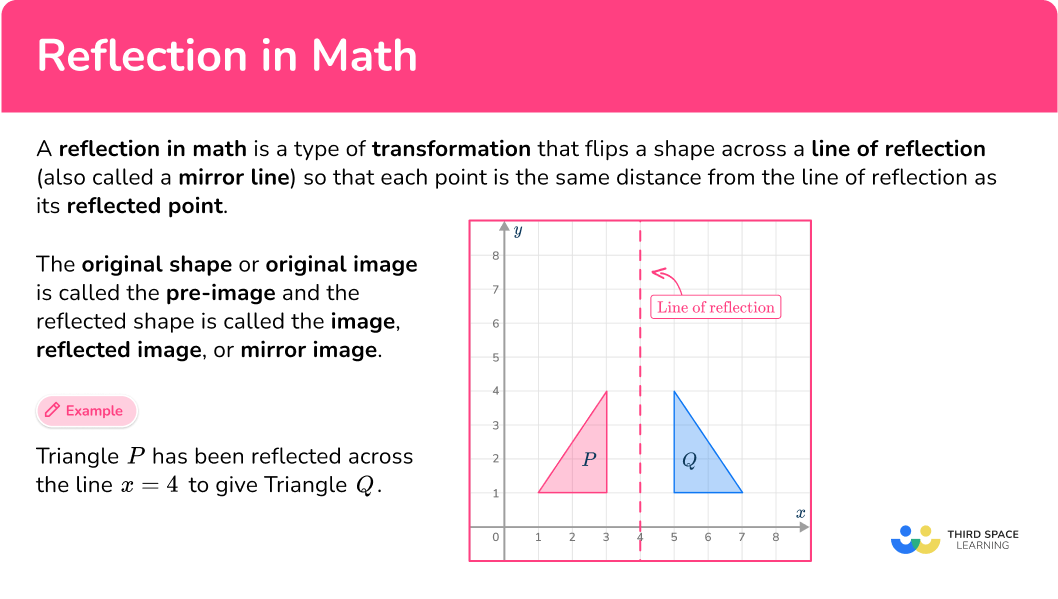
![[FREE] Common Core Practice Tests (Grades 3 to 6)](https://thirdspacelearning.com/wp-content/uploads/2023/10/common-core-practice-tests.png)
[FREE] Common Core Practice Tests (Grades 3 to 6)
![[FREE] Common Core Practice Tests (Grades 3 to 6)](https://thirdspacelearning.com/wp-content/uploads/2023/10/common-core-practice-tests.png)
Prepare for math tests in your state with these Grade 3 to Grade 6 practice assessments for Common Core and state equivalents. 40 multiple choice questions and detailed answers to support test prep, created by US math experts covering a range of topics!
DOWNLOAD FREE![[FREE] Common Core Practice Tests (Grades 3 to 6)](https://thirdspacelearning.com/wp-content/uploads/2023/10/common-core-practice-tests.png)
[FREE] Common Core Practice Tests (Grades 3 to 6)
![[FREE] Common Core Practice Tests (Grades 3 to 6)](https://thirdspacelearning.com/wp-content/uploads/2023/10/common-core-practice-tests.png)
Prepare for math tests in your state with these Grade 3 to Grade 6 practice assessments for Common Core and state equivalents. 40 multiple choice questions and detailed answers to support test prep, created by US math experts covering a range of topics!
DOWNLOAD FREECommon Core State Standards
How does this relate to 8 th grade math and high school math?
- Grade 8 – Geometry (8.G.A.3)
Describe the effect of dilations, translations, rotations, and reflections on two-dimensional figures using coordinates.
- High School – Geometry – Congruence (HS.G.CO.A.5)
Given a geometric figure and a rotation, reflection, or translation, draw the transformed figure using, example, graph paper, tracing paper, or geometry software. Specify a sequence of transformations that will carry a given figure onto another.
- High School – Geometry – Congruence (HS.G.CO.B.6)
Use geometric descriptions of rigid motions to transform figures and to predict the effect of a given rigid motion on a given figure; given two figures, use the definition of congruence in terms of rigid motions to decide if they are congruent.
How to use reflections
In order to reflect a shape on a grid:
- Reflect the first point or vertex.
- Reflect all other points or vertices.
- Finish the diagram.
Reflection in math examples
Example 1: reflect a shape on a grid (horizontal line of reflection)
Reflect the shape in the line:
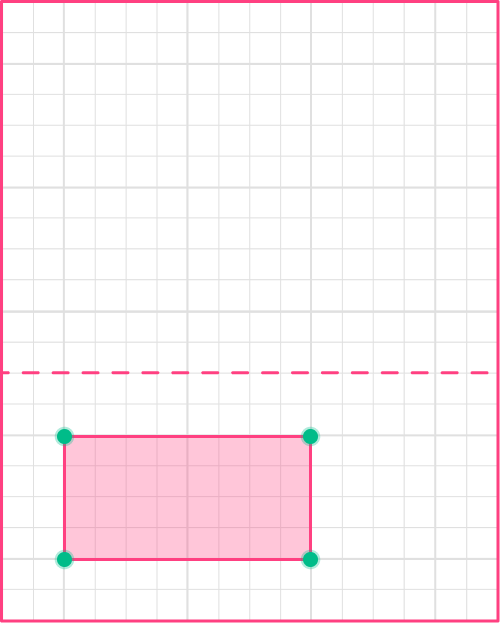
- Reflect the first point or vertex.
Choose the first point to reflect. It is easier to start with a point that is closest to the line of reflection (the mirror line). The new point will be exactly the same distance away from the line of reflection as the original point.
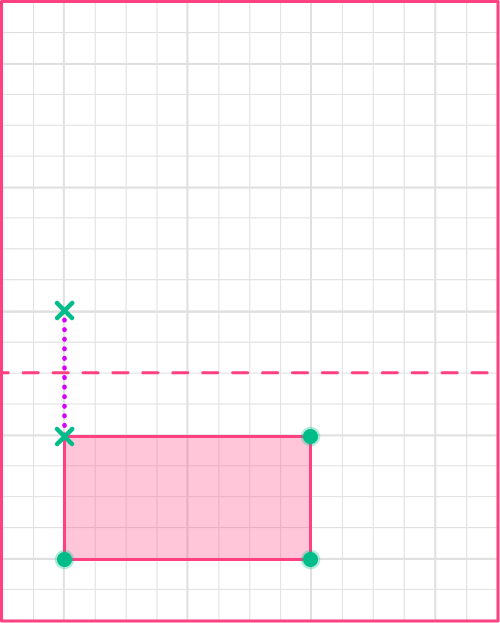
Here, the point is two squares away from the line of reflection, so the reflected point is two squares away from the line of reflection in the other direction.
2Reflect all other points or vertices.
Here is a second point being reflected to give its image. Again, this point is two squares away from the line of reflection and so the reflected point is two squares away in the other direction. The remaining two points have also been added, both are 6 squares away from the line of reflection.
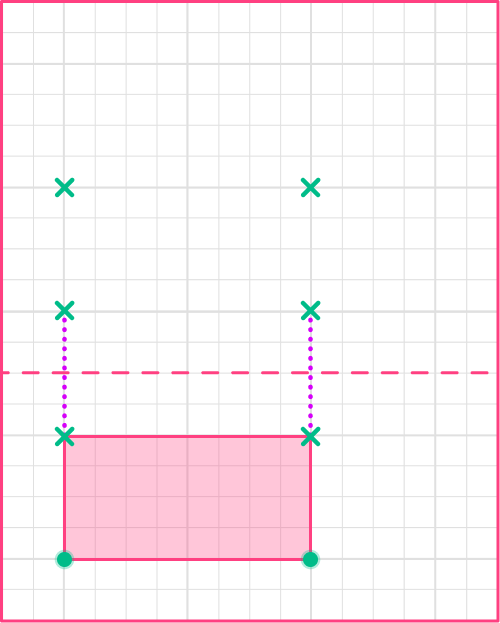
3Finish the diagram.
To finish the diagram, join up the reflected points.
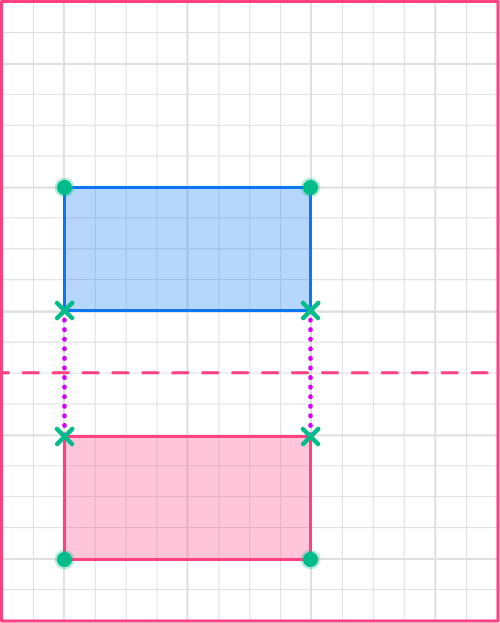
Example 2: reflect a shape on a grid (diagonal line of reflection)
Reflect the rectangle across the line:
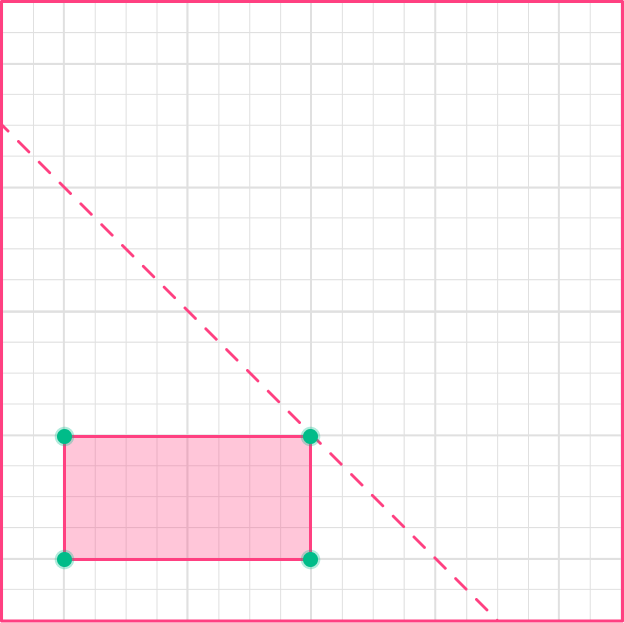
Reflect the first point or vertex.
Choose the first vertex to reflect. It is easier to start with a vertex which is closest to the line of reflection (the mirror line). The new vertex will be exactly the same distance away from the line of reflection as the original vertex.
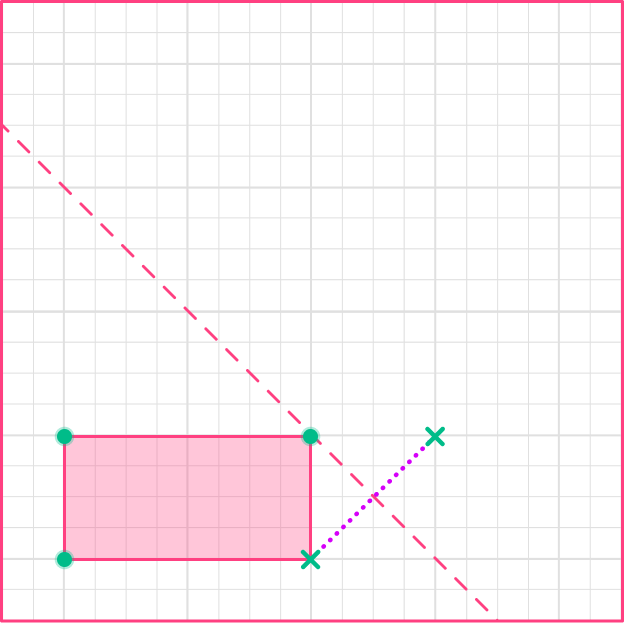
Here the point is two square diagonals from the line of reflection and so the reflected vertex is two square diagonals from the line of reflection in the other direction.
Reflect all other points or vertices.
Here, the second and third vertices are reflected to give its image. The remaining vertex is on the line of reflection and does not move (it is an invariant point).
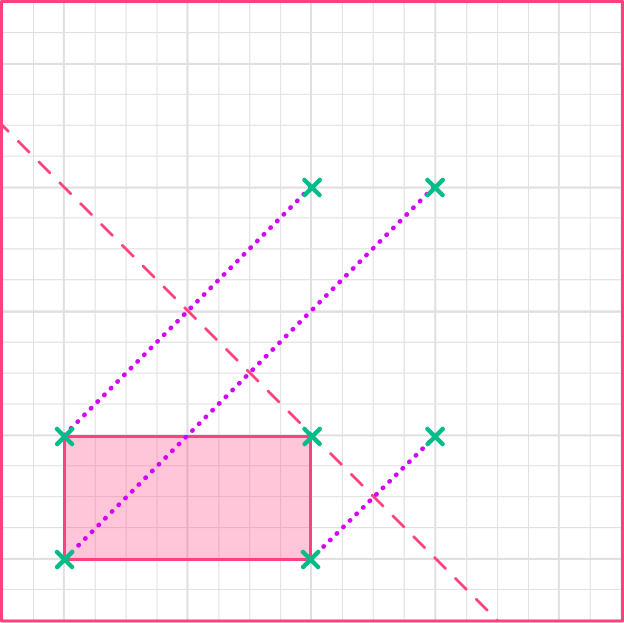
Finish the diagram.
To finish the diagram, join up the reflected vertices.
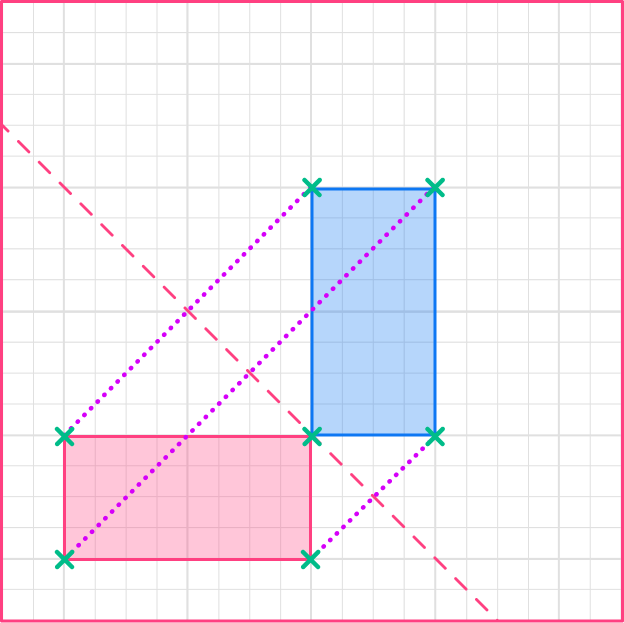
How to use reflections on a coordinate grid
In order to reflect a shape on a coordinate grid:
- Draw the line of reflection.
- Reflect the first point or vertex.
- Reflect all other points or vertices.
- Finish the diagram.
Reflections on a coordinate grid examples
Example 3: reflect a shape on a coordinate grid
Reflect Triangle P across the line x=4\text{:}
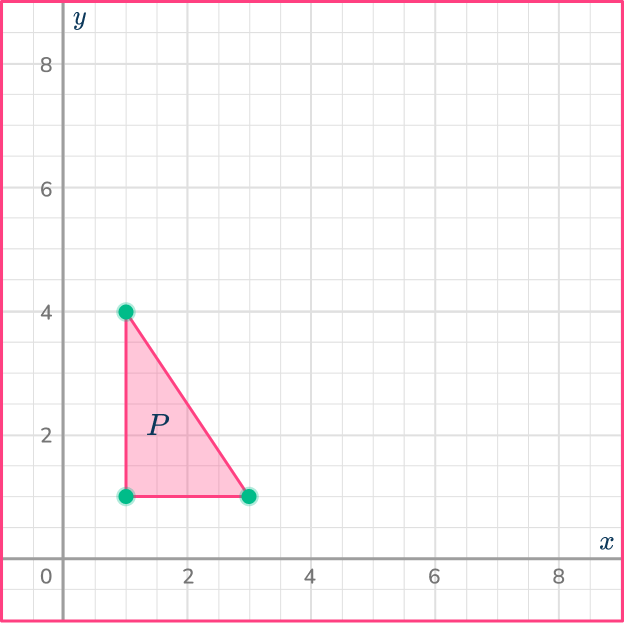
Draw the line of reflection.
The line of reflection is x=4 (the mirror line). This is a vertical line that intersects the x -axis at 4. Draw this on the diagram.
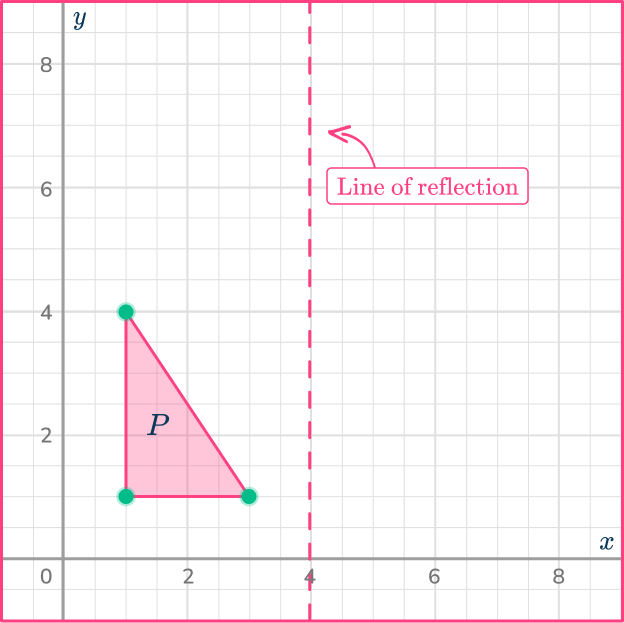
Reflect the first point.
Choose the first point to reflect. It is easier to start with a point which is closest to the line of reflection (the mirror line). Let’s reflect the point at (3, \, 1). The new point will be exactly the same distance away from the line of reflection as the original point.
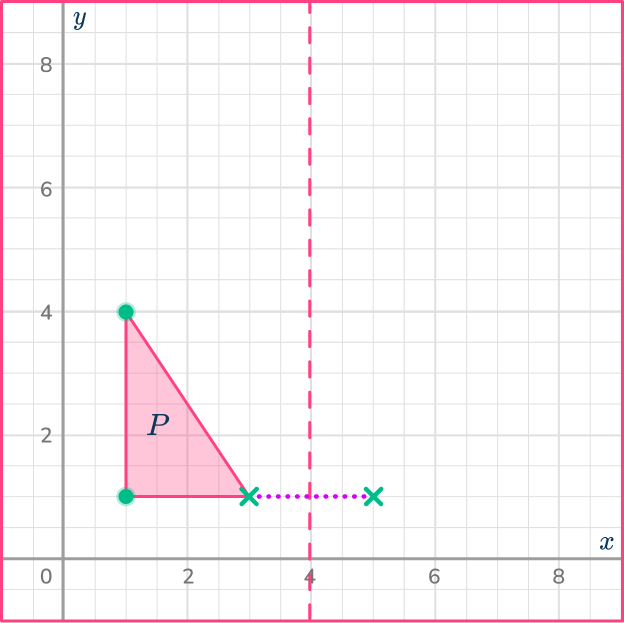
Reflect the other points.
Here the second point (1, \, 4) is being reflected to give its image.
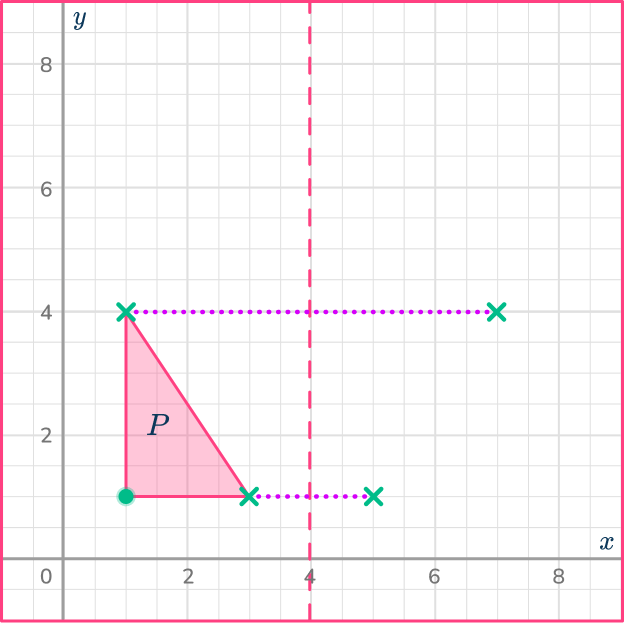
You can then reflect the third point (1, \, 1).
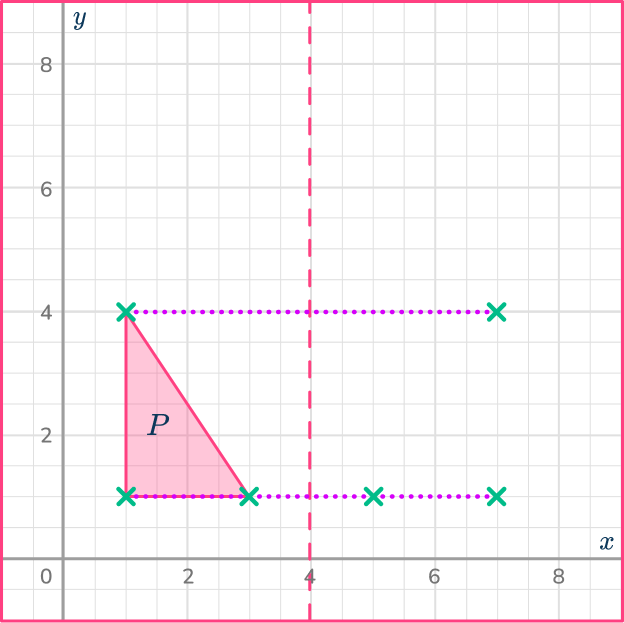
Finish the diagram.
To finish the diagram, join up the reflected points.
Here, Triangle Q is the image of Triangle P.
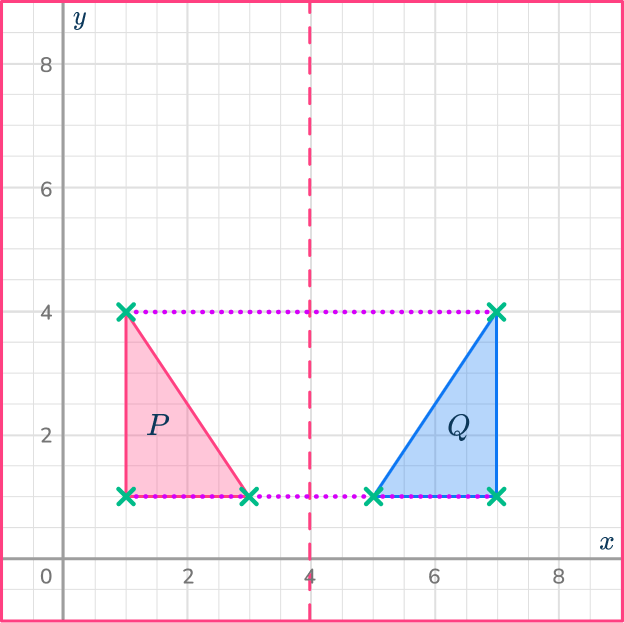
Example 4: reflect a shape on a coordinate grid
Reflect Triangle P across the line y=3\text{:}
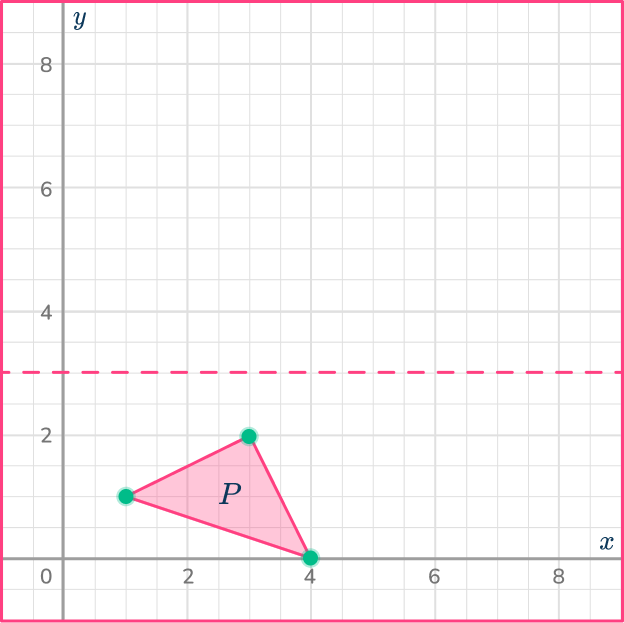
Draw the line of reflection.
The line of reflection is y=3 (the mirror line). This is a horizontal line that intersects the y -axis at 3. Draw this on the diagram.
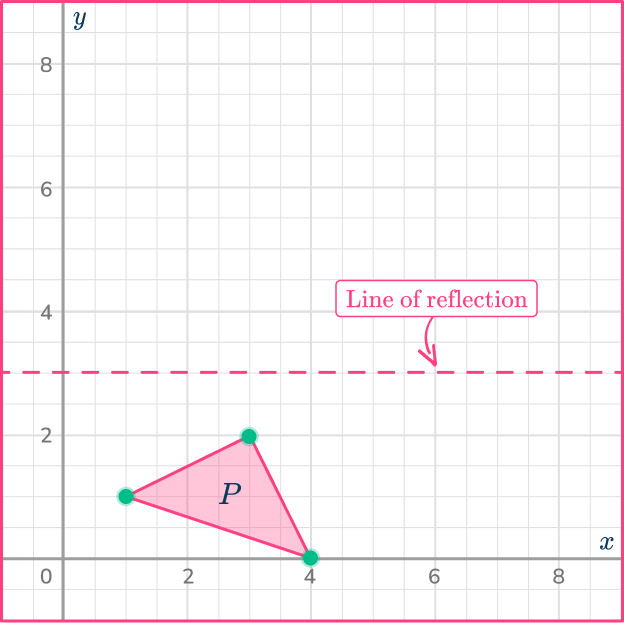
Reflect the first point.
Choose the first vertex to reflect. It is easier to start with a vertex which is closest to the line of reflection (the mirror line). Let’s reflect the vertex (3, \, 2). The new vertex will be exactly the same distance away from the line of reflection as the original vertex.
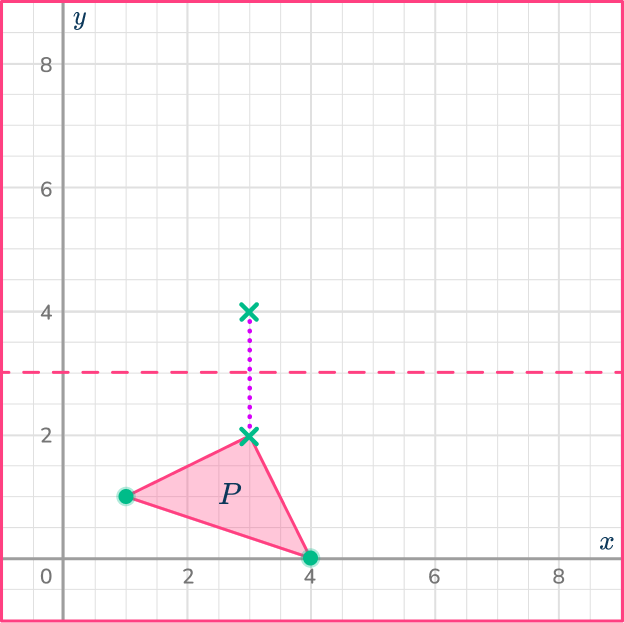
Reflect the other points.
Here, the second vertex (1, \, 4) is being reflected to give its image.
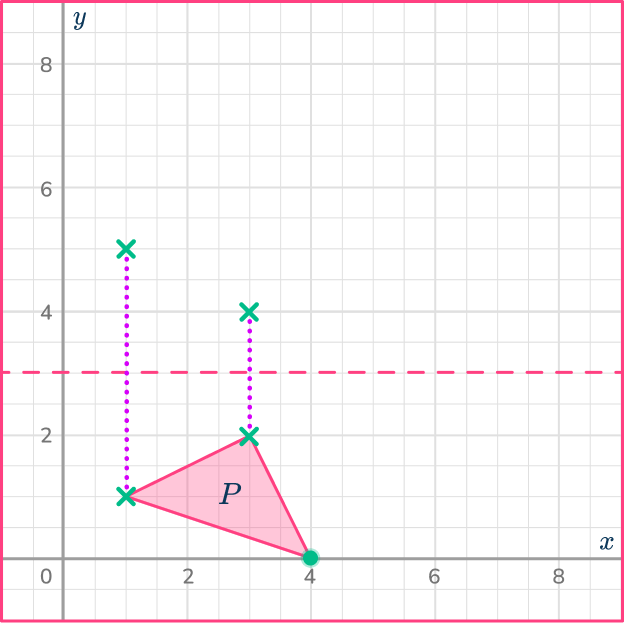
You can then reflect the third vertex (4, \, 0).
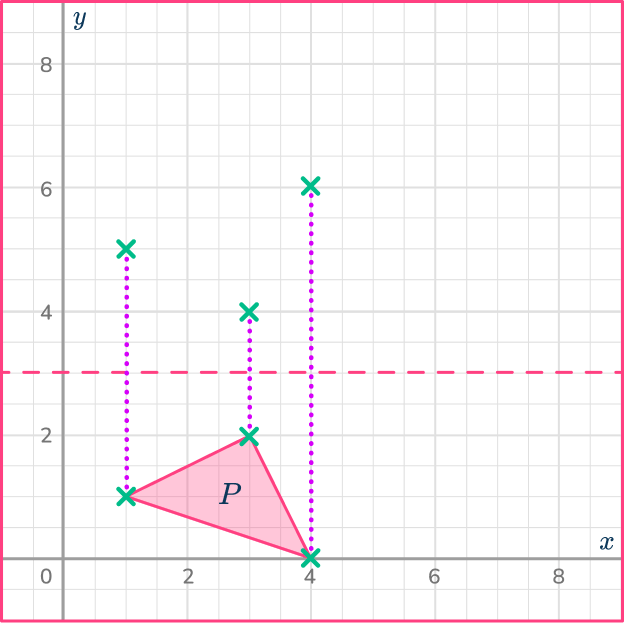
Finish the diagram.
To finish the diagram, join up the reflected vertices.
Here, Triangle Q is the image of Triangle P.
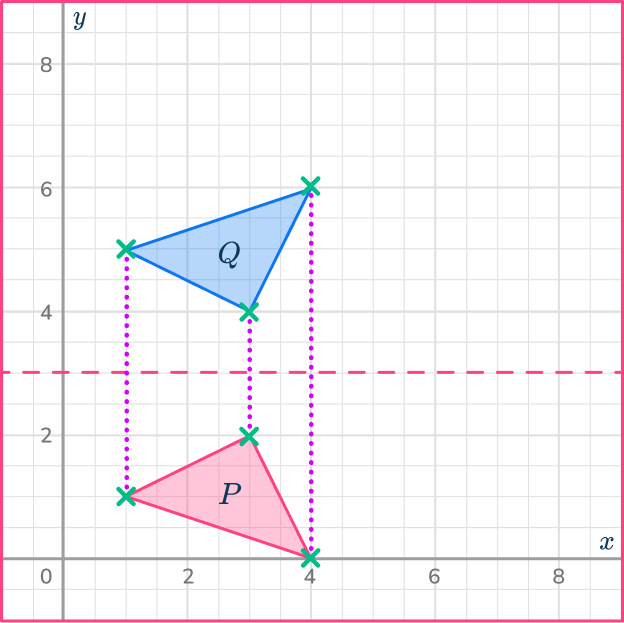
How to describe reflections
In order to describe a reflection of a shape on a coordinate grid:
- Pair up the points.
- Identify the midpoints.
- Join the midpoints.
- State the equation of the line.
Describing reflections examples
Example 5: describe a reflection (horizontal line)
Describe the transformation of Shape A to Shape B.
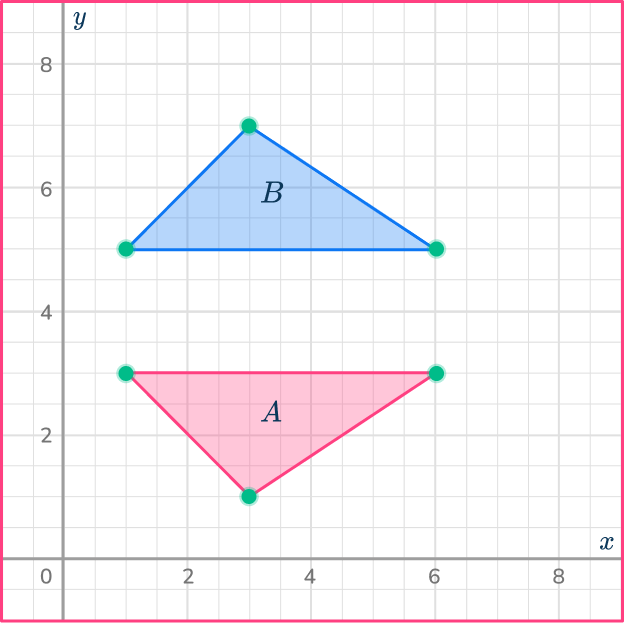
Pair up the points.
Try to match up the corresponding point on the two shapes and draw a connecting line segment. Do this with at least two sets of points.
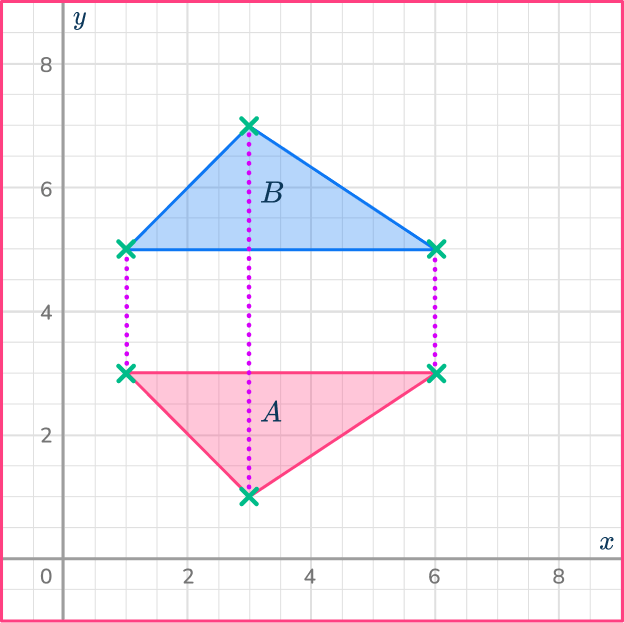
Identify the midpoints.
Identify the midpoints of these connecting lines. This will help you draw the line of reflection.
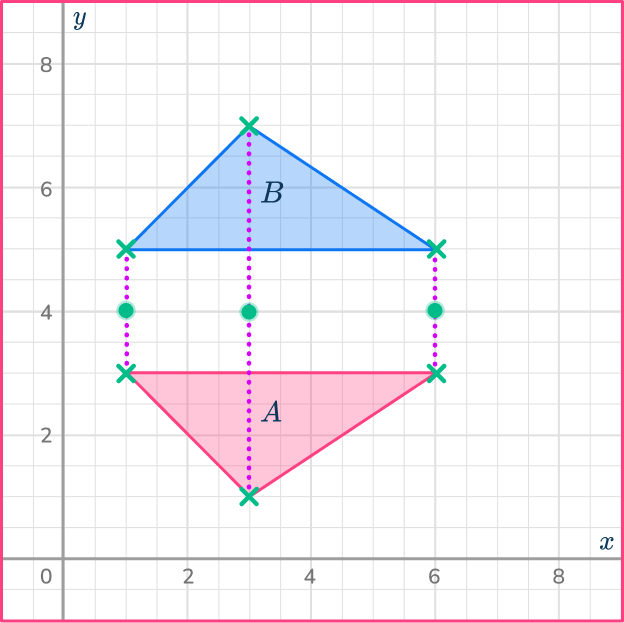
Join the midpoints.
Draw a straight line through the midpoints.
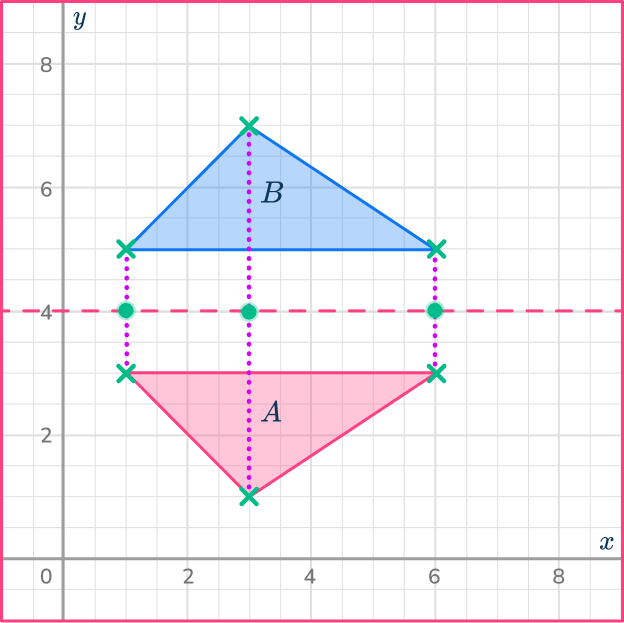
State the equation of the line.
The horizontal line intersects the y -axis at 4 so the equation of the line is y=4.
The transformation is a reflection across the line y=4.
Example 6: describe a reflection (diagonal line)
Describe the transformation of Shape A to Shape B.
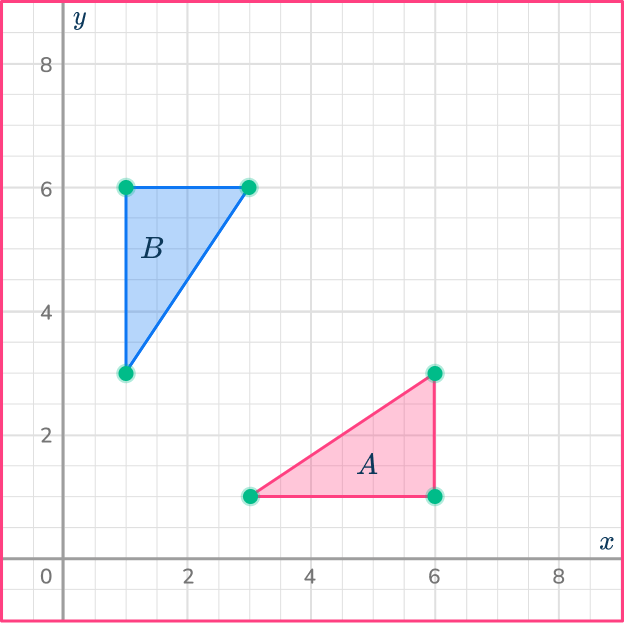
Pair up the points.
Try to match up the corresponding point on the two shapes and draw a connecting line segment. Do this with at least two sets of points.
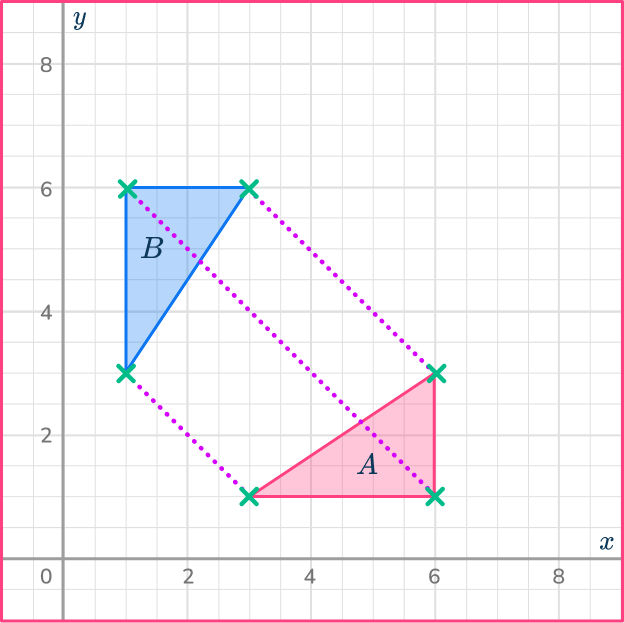
Identify the midpoints.
Identify the midpoints of these connecting lines. This will help us draw the line of reflection.
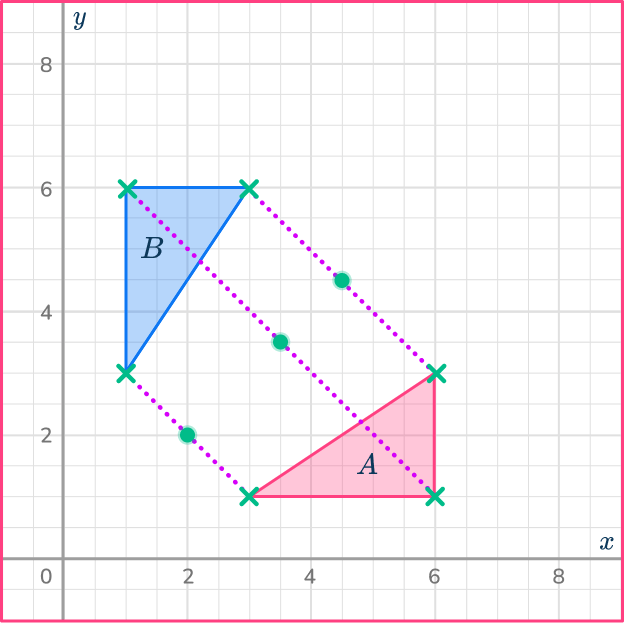
Join the midpoints.
Draw a straight line through the midpoints.
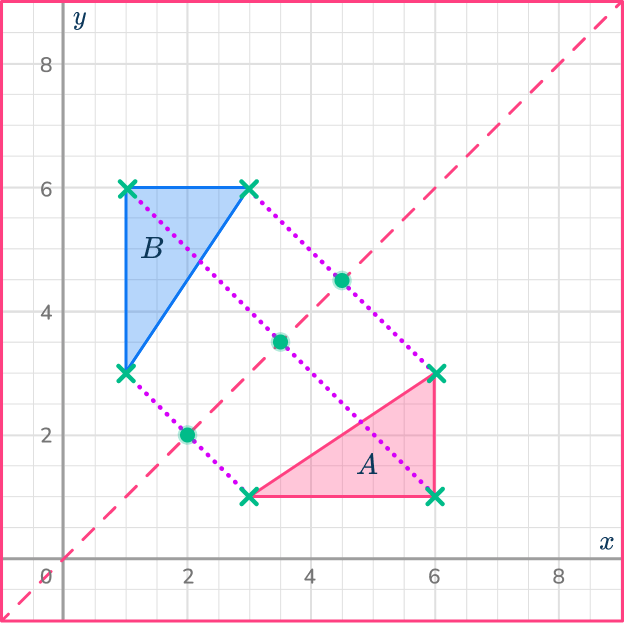
State the equation of the line.
Looking at the coordinates of the midpoints, (2, \, 2), \, (3.5, \, 3.5) and (4.5, \, 4.5) the x – and y -values of each point are the same. The equation of the line is therefore y=x.
The transformation is a reflection in the line y=x.
Teaching tips for reflections in math
- Begin with basic shapes like triangles and rectangles to demonstrate reflections.
- Have students cut out shapes and physically flip them over a line on paper.
- Discuss examples of symmetry and reflections in nature, such as butterfly wings and human faces.
- Teach the rules for reflecting points over the x -axis, y -axis, and other lines ( example, (x, \, y) becomes (- \, x, \, y) over the y -axis and (x, \, - \, y) over the x -axis ).
- Allow students to look for patterns in the coordinates of the corresponding points.
For example, in triangle ABC, if point A has coordinates (3, \, 4) in the original shape, and it was reflected over the y -axis, what are the coordinates of point a in the reflected image?
Easy mistakes to make
- Thinking that shapes can’t overlap
The original shape (the object) and its reflection (the image) are allowed to overlap each other.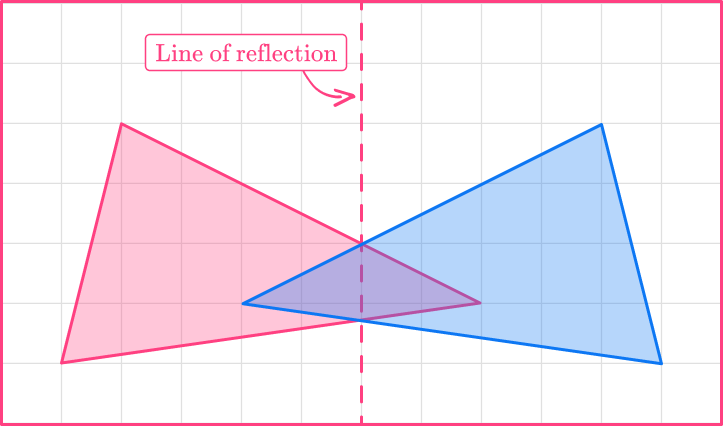
- Struggling with diagonal lines of reflection
Diagonal lines of reflection can be tricky. It is worth turning the diagram so that the line of reflection is either horizontal or vertical to make the reflections easier to carry out.
- Not describing transformations fully
When you are asked to describe a transformation, be sure to state which kind of transformation it is and any other details. For reflections, you need to state that it is a reflection and give the equation of the line of reflection.
Related transformations lessons
Practice reflection maths questions
1. Reflect the shape across the line of reflection:
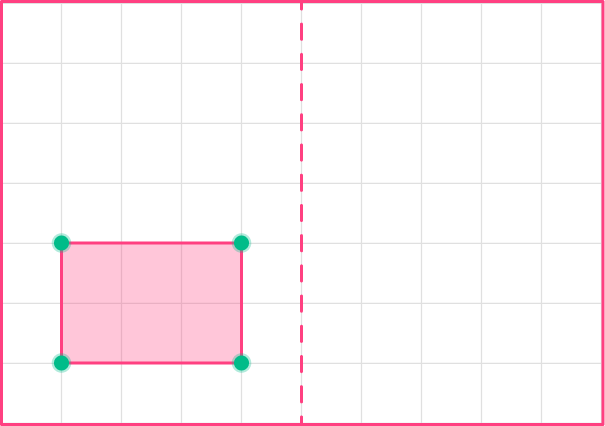
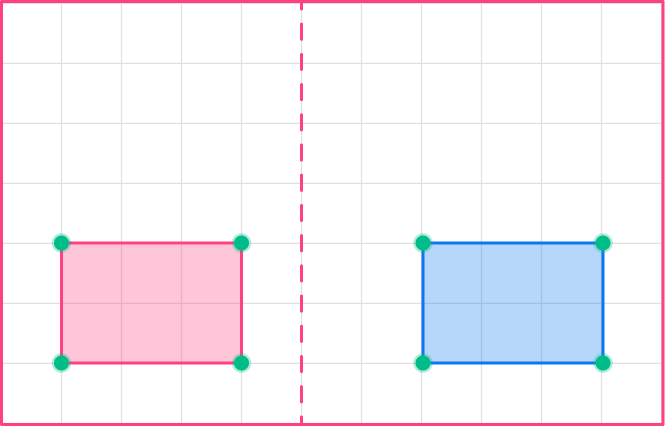

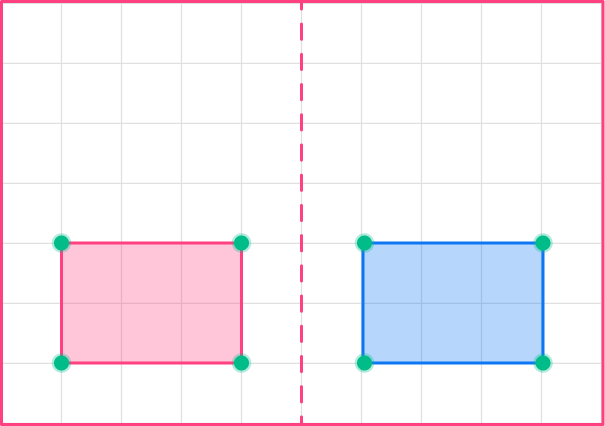

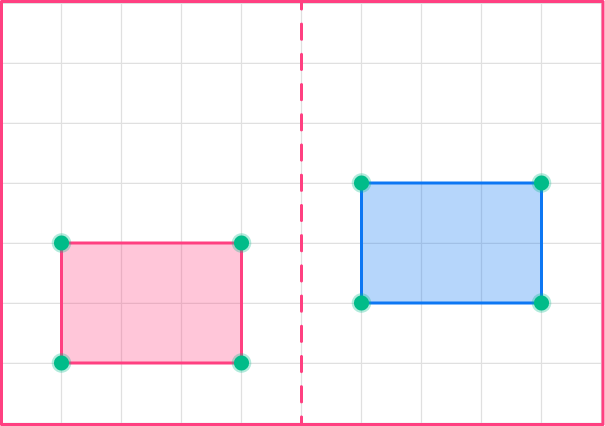

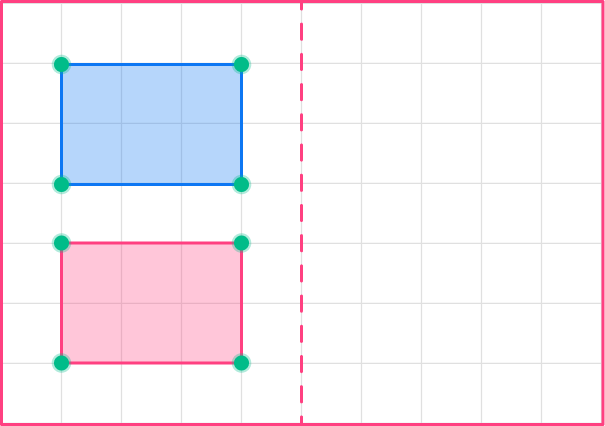

The corresponding points on the object and the image must be equidistant (the same distance) from the line of reflection.
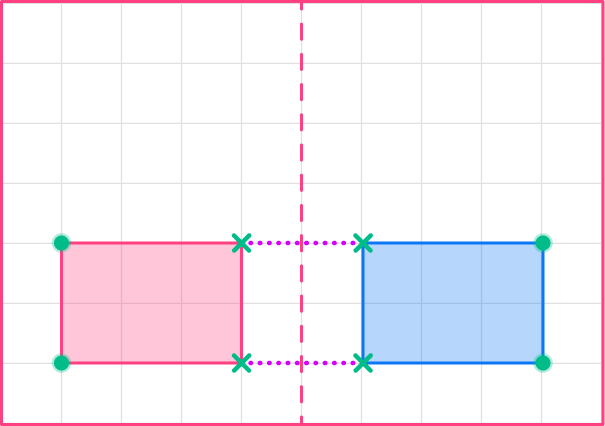
2. Reflect the shape across the line of reflection:
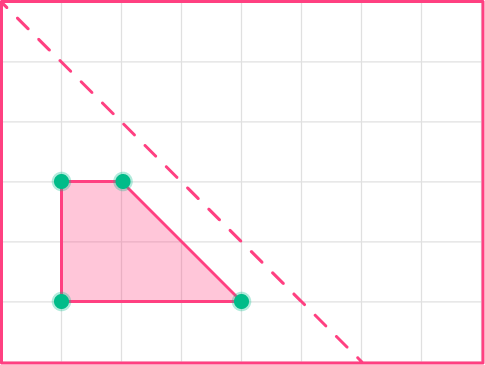
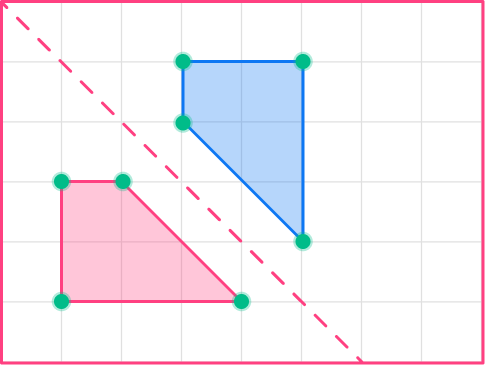

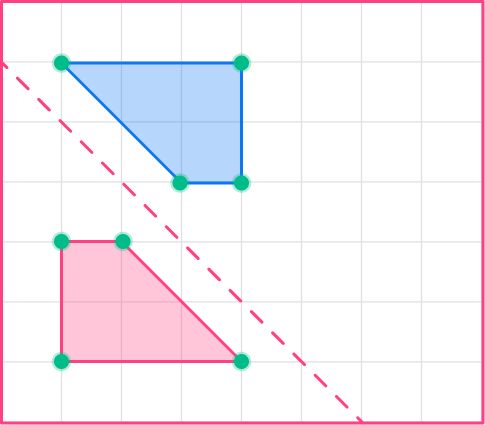

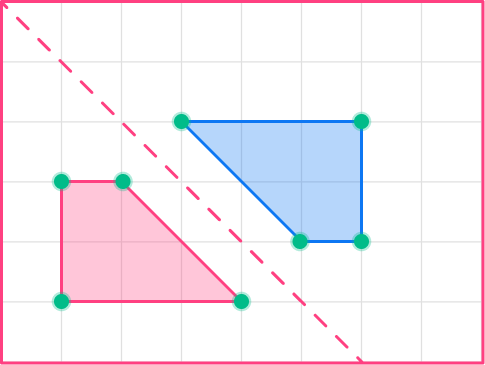

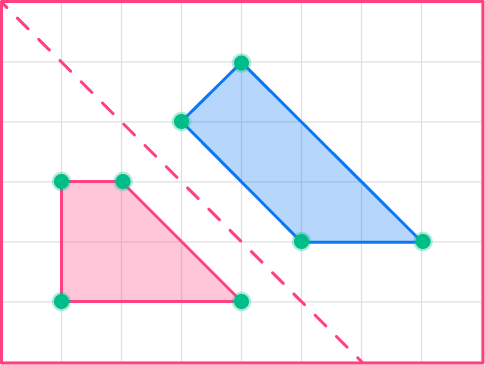

The corresponding points on the object and the image must be equidistant (the same distance) from the line of reflection.
The object and the image should be congruent – the same shape and the same size.
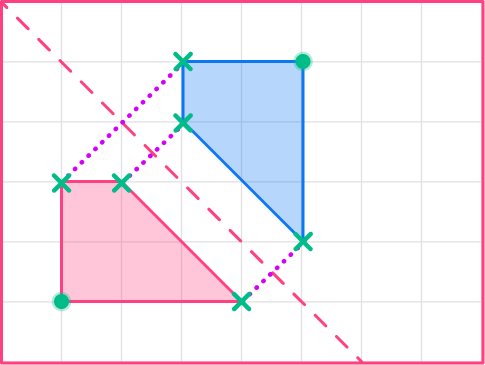
3. Reflect the shape across the line y=4\text{:}
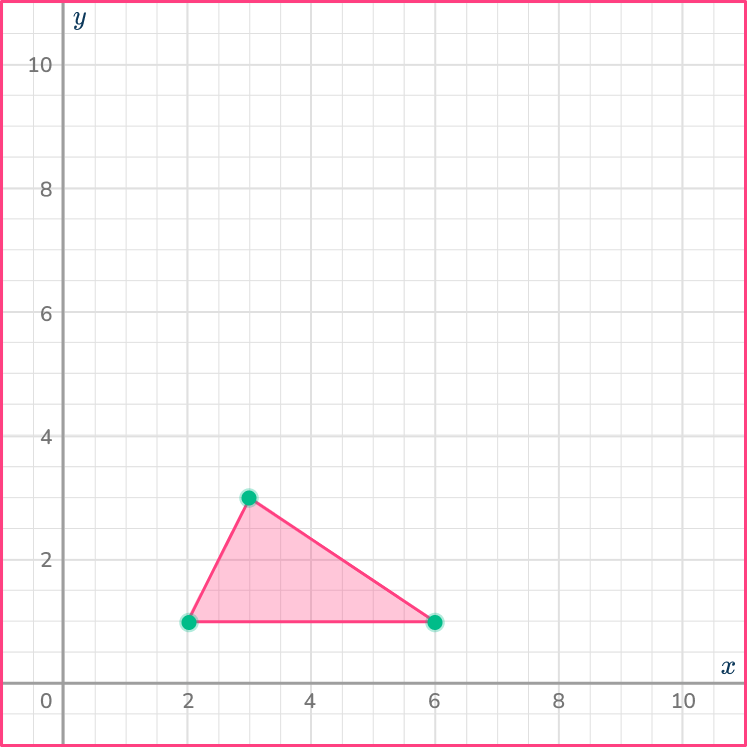
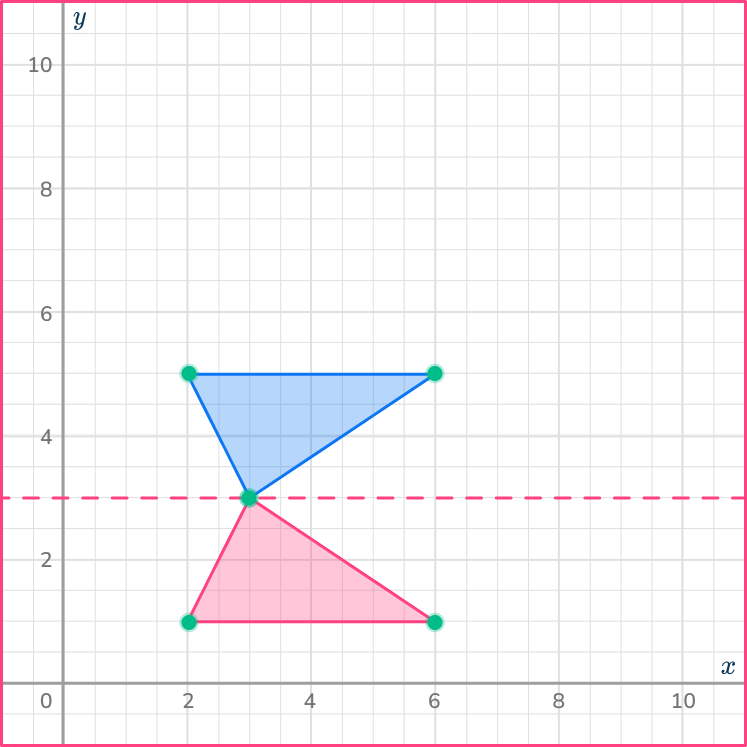

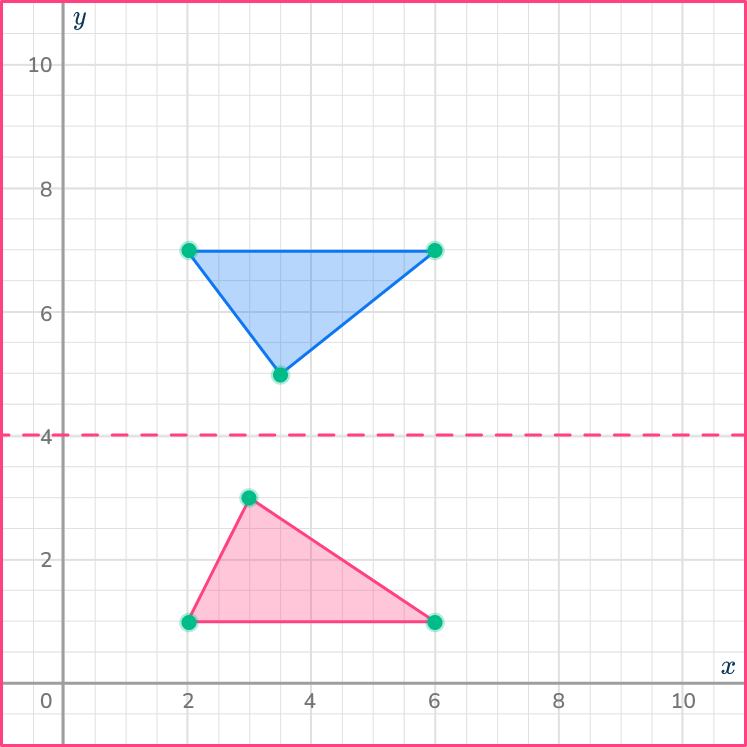

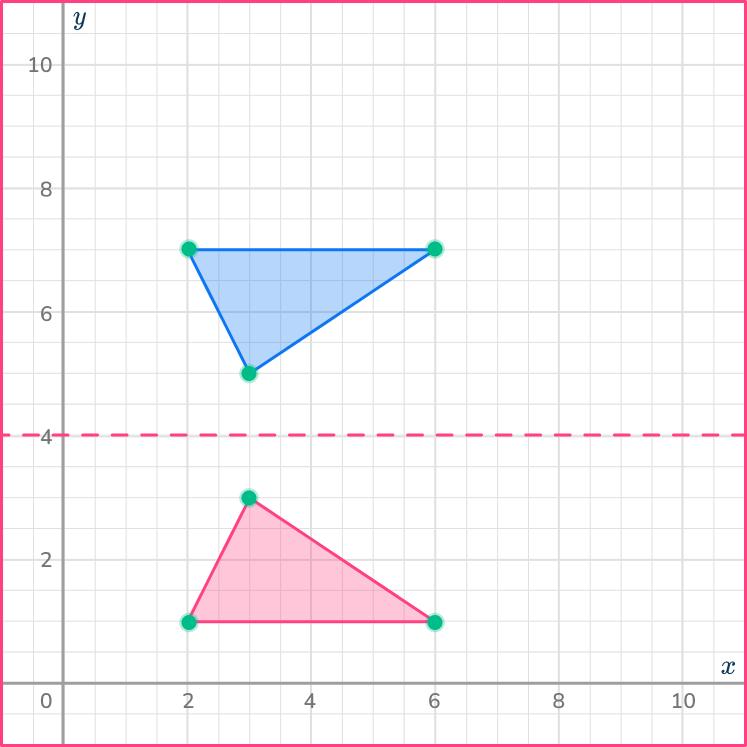

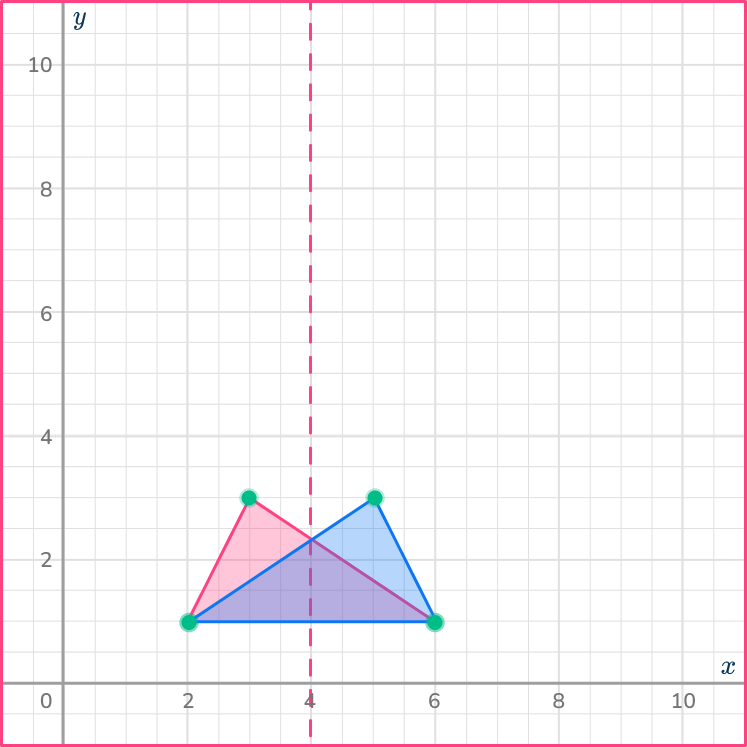

The line y=4 is a horizontal line going through 4 on the y -axis.
The corresponding points on the object and the image must be equidistant (the same distance) from the line of reflection.
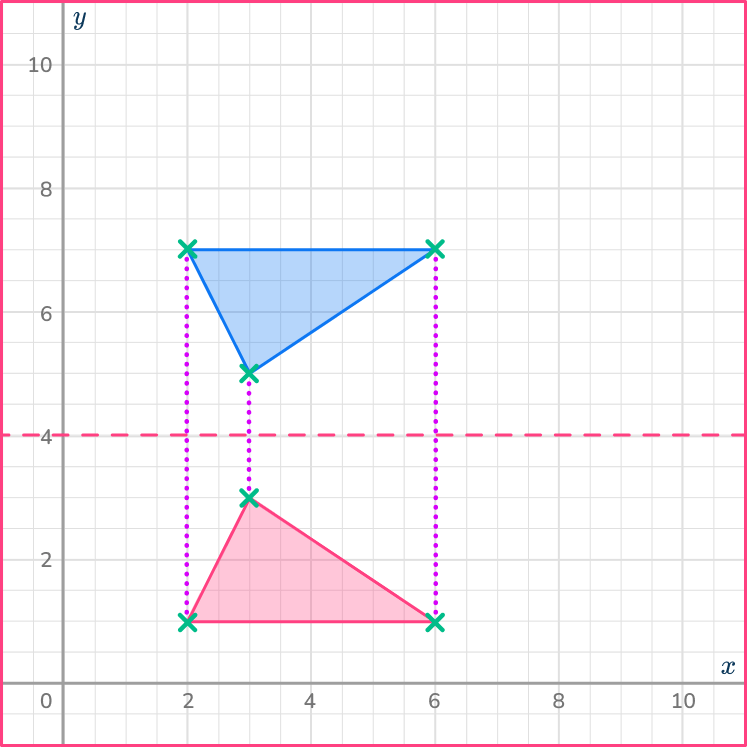
4. Reflect the shape in the y -axis:
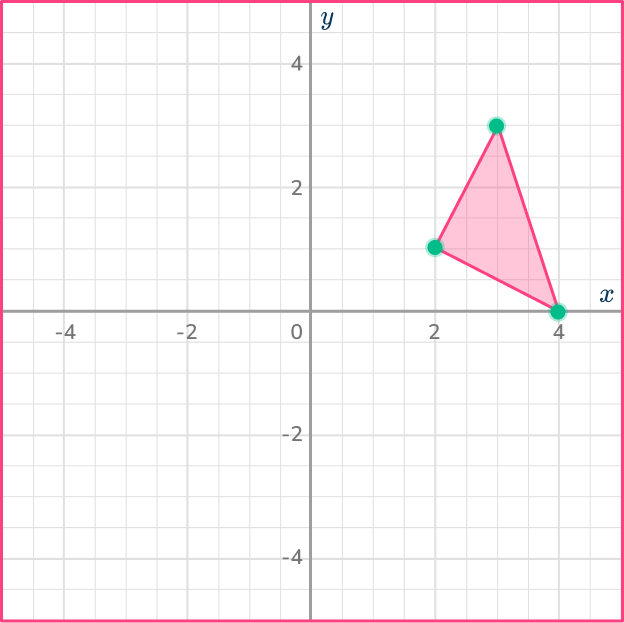
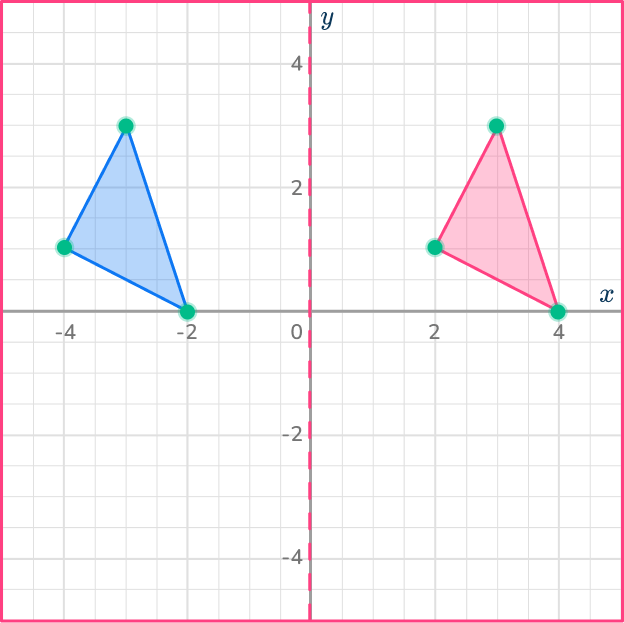

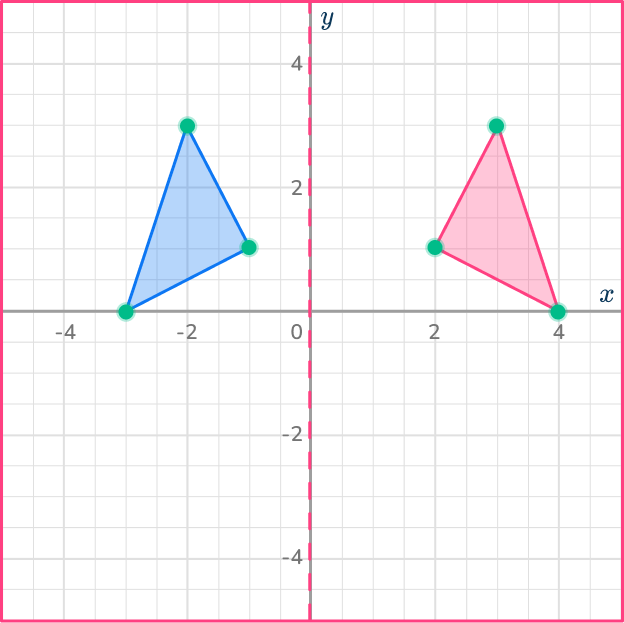

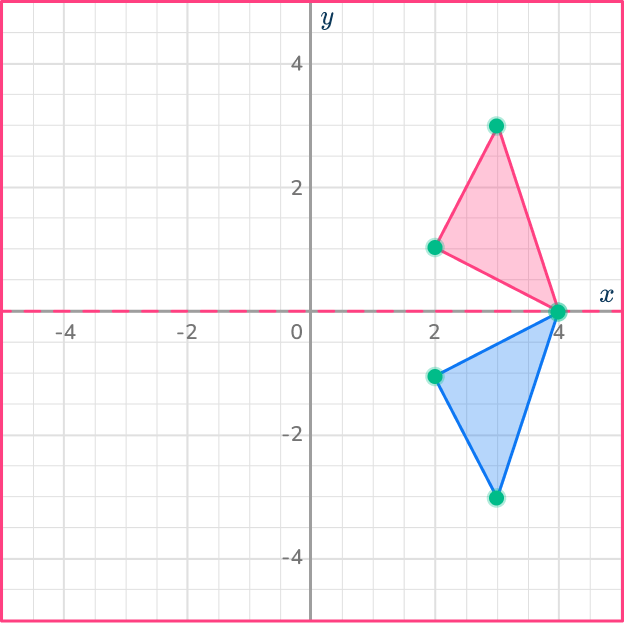

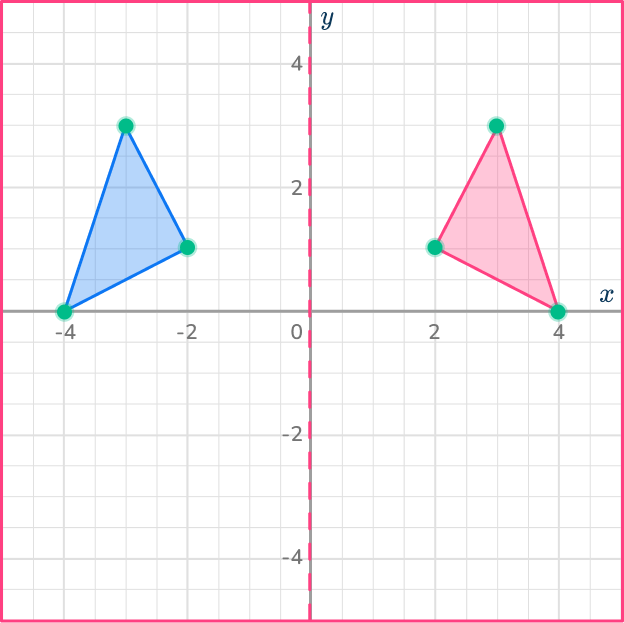

The y -axis is the vertical axis.
The corresponding points on the object and the image must be equidistant (the same distance) from the line of reflection.
The object and the image should be congruent – the same shape and the same size.
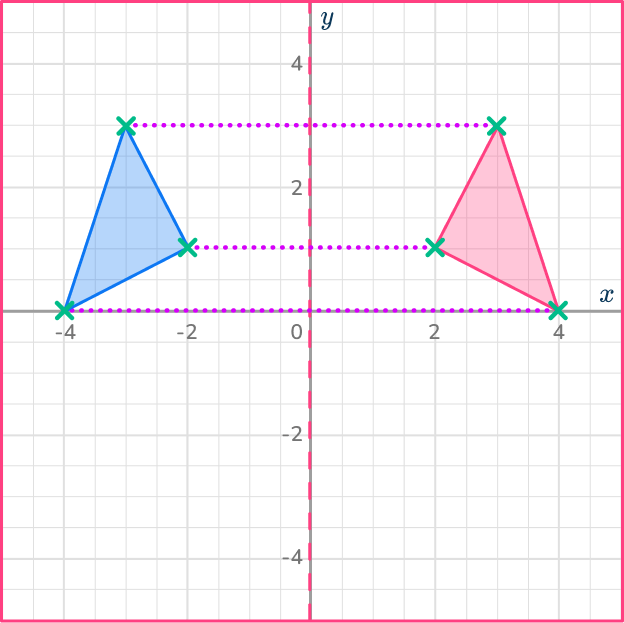
5. Describe the transformation of Shape P to Shape Q.
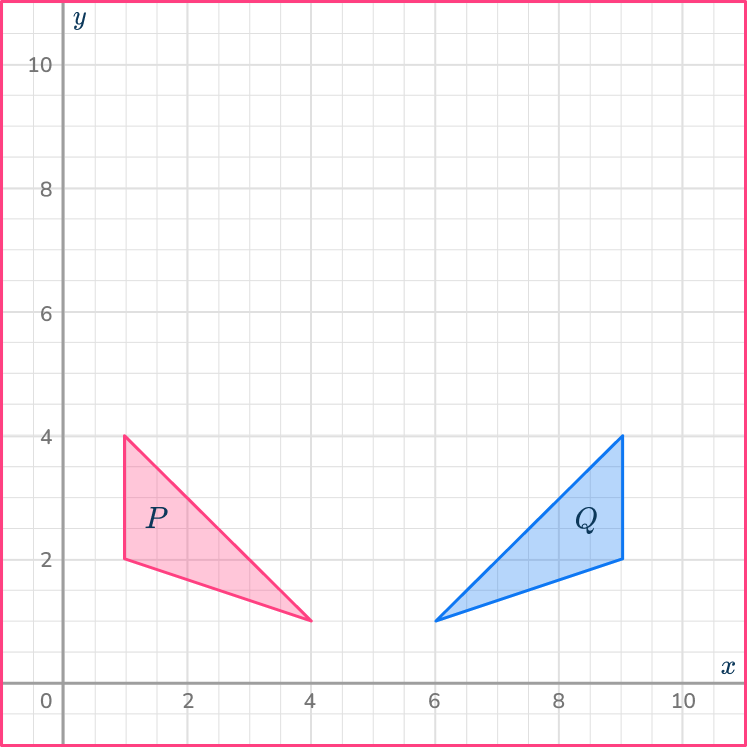
Reflection across x=6

Transformation in x=5

Reflection across y=5

Reflection across x=5

You must state that the transformation is a reflection.
The line of reflection is a vertical line, so the equation is x=a, where a is the same as the intercept with the x -axis, 5.
The corresponding points on the object and the image must be equidistant (the same distance) from the line of reflection.
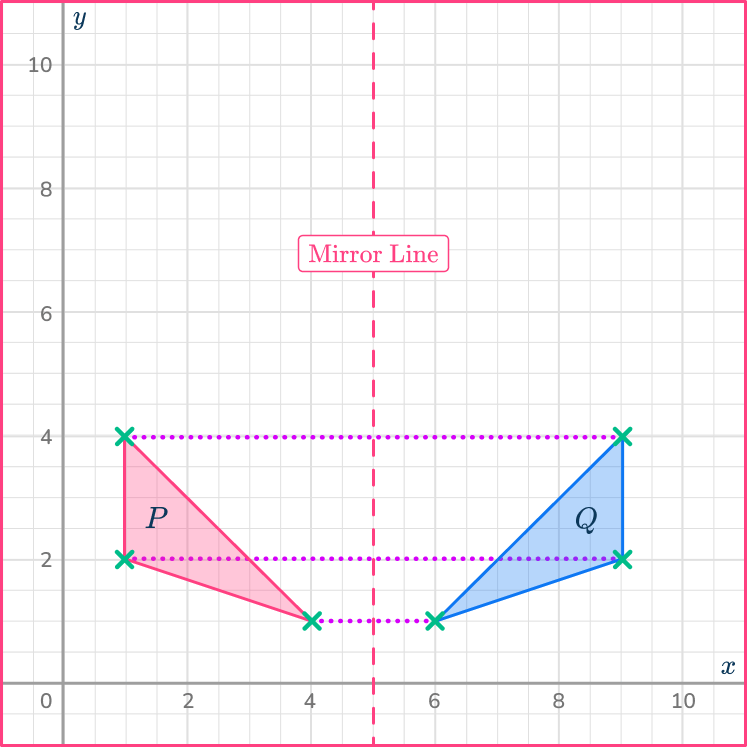
6. Describe the reflection of Shape P to Shape Q .
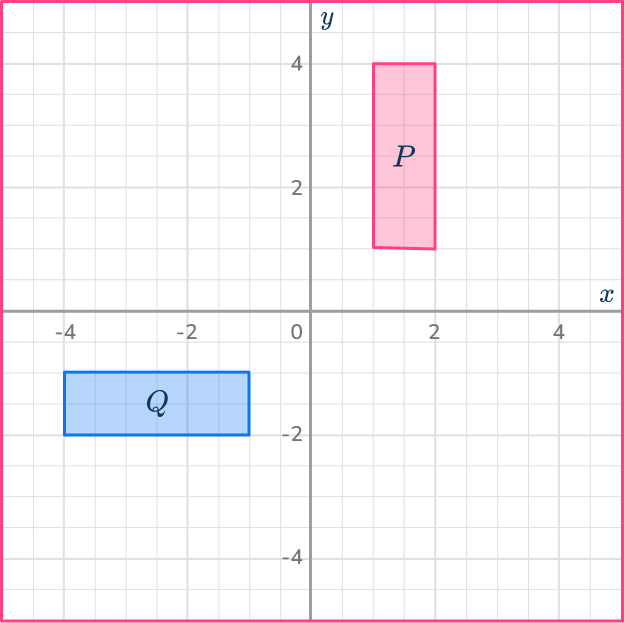
Reflection across the x -axis

Reflection across the y -axis

Reflection across y=- \, x

Reflection across y=x

The line of reflection is a diagonal line.
The corresponding points on the object and the image must be equidistant (the same distance) from the line of reflection.
The line of reflection goes through the points (1, \, – \, 1), \, (2, \, – \, 2), \, (3, \, – \, 3) and so on.
The y -coordinate is the negative of the x -coordinate so y=- \, x.
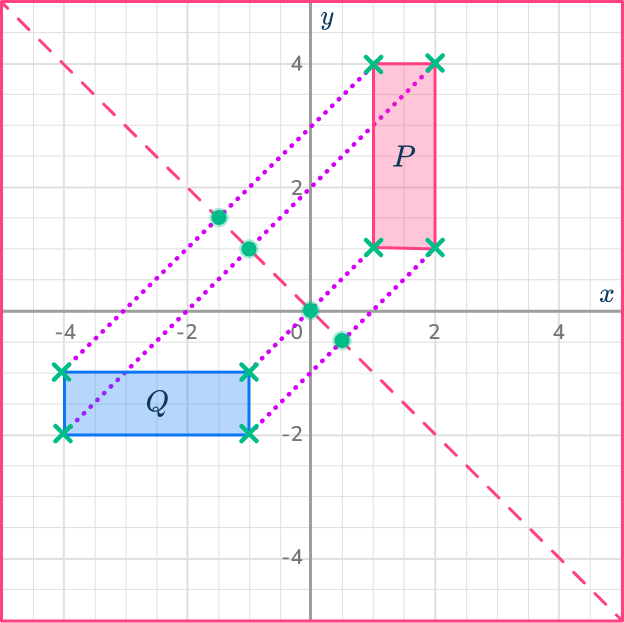
Reflection in math FAQs
A reflection is a transformation that flips a figure over a line, creating a mirror image of the original figure on the opposite side of the line.
A vertical reflection flips a figure over a vertical line (like the y -axis), changing the sign of the x -coordinates. A horizontal reflection flips a figure over a horizontal line (like the x -axis), changing the sign of the y -coordinates.
When a figure is reflected over a line, each point of the figure is mapped to a point directly opposite it on the other side of the line, at the same distance from the line.
Invariant points are points that do not change position during a reflection. Points on the line of reflection are invariant points.
Still stuck?
At Third Space Learning, we specialize in helping teachers and school leaders to provide personalized math support for more of their students through high-quality, online one-on-one math tutoring delivered by subject experts.
Each week, our tutors support thousands of students who are at risk of not meeting their grade-level expectations, and help accelerate their progress and boost their confidence.

Find out how we can help your students achieve success with our math tutoring programs.
[FREE] Common Core Practice Tests (3rd to 8th Grade)
Prepare for math tests in your state with these 3rd Grade to 8th Grade practice assessments for Common Core and state equivalents.
Get your 6 multiple choice practice tests with detailed answers to support test prep, created by US math teachers for US math teachers!